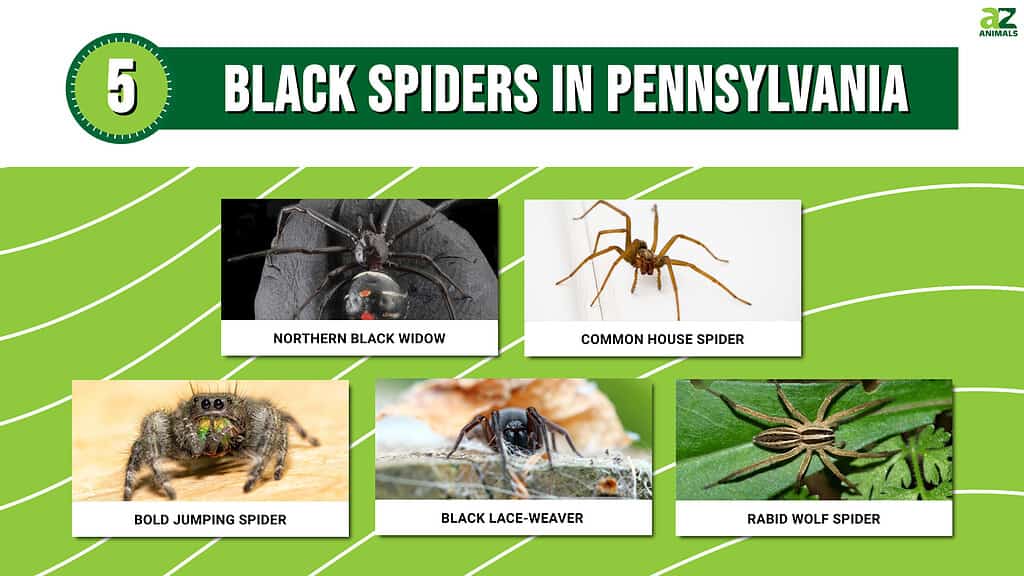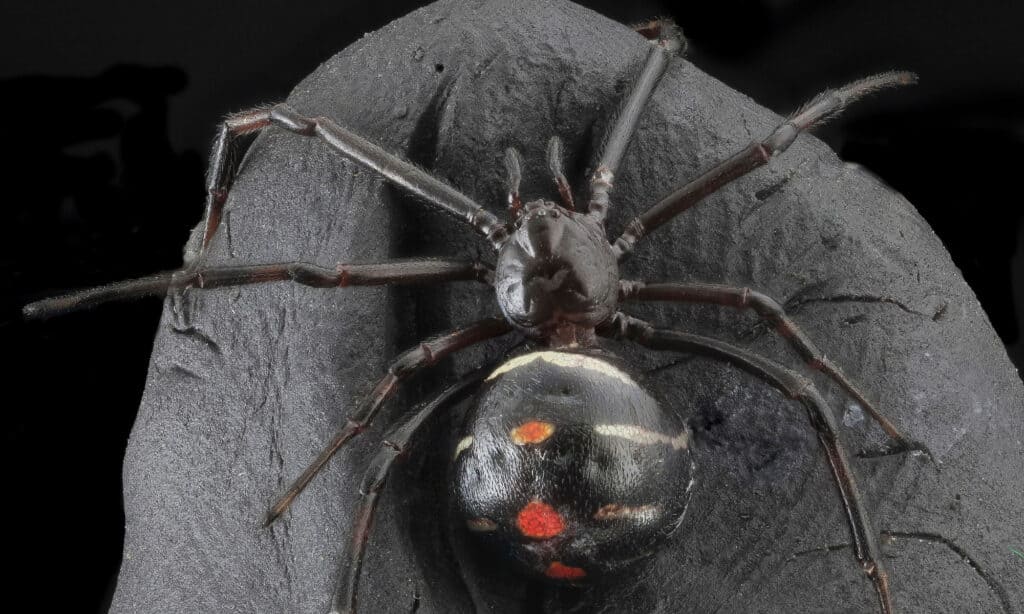In Pennsylvania, wildlife abounds. From white-tailed deer to red-tailed hawks and black bears, this state is brimming with over 25,000 species of recognized creatures. While there are animals like mammals that take up tons of space, sometimes towering over you, there are also tinier creatures that often go unnoticed like insects and arachnids. There is an array of spider species that call Pennsylvania home, but in this article, we focus specifically on black spiders!

5 Black Spiders in Pennsylvania
1. Northern Black Widow
Scientific Name: Latrodectus variolus

Unlike other black widows, northern black widows have a broken hourglass-shaped marking on their abdomens
©Porco_Rosso/Shutterstock.com
The northern black widow is rampant in the state of Pennsylvania. This spider is recognized as the most venomous found throughout North America. Though most commonly known as the black widow, this spider also goes by cobweb spider, tangle-web spider, hourglass spider, and shoe button spider. It’s primarily black but may have some brown, white, red, and orange colorations. The good news about these venomous spiders is that they are not typically found indoors. They prefer outdoor settings near man-made structures in both low and high foliage. They may be attracted to debris or rocks as well. These are most often spotted during May but make appearances during the rest of the year except for the winter months when temperatures dip.
2. Common House Spider
Scientific Name: Parasteatoda tepidariorum

Common house spiders are like ungrateful guests, spinning messy spider webs both outside and inside man-made structures.
©Sample Stars/Shutterstock.com
Common house spiders are like ungrateful guests, spinning messy spider webs both outside and inside man-made structures like buildings and barns. They are different colors, sometimes on the lighter side like tan but may also be almost completely black. Although their webs are messy, they are fantastic for catching prey like insects. They’re not always easy to spot because of their colorations; they typically blend into their environment well. However, if you want to clear them out, look at your windows and in the corners of each room. They may also set up their homes around rocks and boards. Like a messy roommate that leaves a trail of laundry, telling of their whereabouts, these spiders move frequently and leave a tangled, silky mess behind.
Bold Jumping Spider
Scientific Name: Phidippus audax

The Bold Jumping Spider doesn’t rely on webs, like many other spiders, to catch prey.
©Sari ONeal/Shutterstock.com
You might be able to spot a bold jumping spider in your backyard if you’re looking but these spiders are tiny. Along with backyards, they enjoy environments like open woodlands and grasslands. They are known for their ability to jump great distances of up to 50 times their length. The bold-jumping spider uses this unique ability to pounce on their prey. They don’t rely on webs, like many other spiders, to catch prey. They take a much more active approach and actively hunt, using both their jumping abilities and their great eyesight. This spider is black and hairy with colored spots on the tops of their abdomens that include white, orange, or yellow. The chelicerae of this spider often have a beautiful, iridescent blue-green color. Although they are driven spiders, engaging in hunting behaviors, when they encounter a human, they are quite timid. They retreat quickly and even if handled, it’s unlikely they bite.
4. Black Lace-Weaver
Scientific Name: Amaurobius ferox

The black lace weaver abdomens have a distinctive marking that bears a resemblance to a skull.
©Wildsmith_Westwood/Shutterstock.com
Black lace-weavers are nocturnal spiders with black, brown, and tan colorations. You’re unlikely to spot them unless you’re a night owl yourself. They live both indoors and outdoors but are most commonly seen indoors. They prefer man-made structures and may also settle under debris and rocks. They’re most active in spring and into summer, with the most sightings occurring during April. This is when the males are on the lookout for females to mate with. These spiders are a brownish-red color but may also appear almost completely black. On their abdomens, they have a distinctive marking that bears a resemblance to a skull. Only some have it fully defined; others may have faded markings that are more difficult to identify. These spiders are deemed “subsocial” because the spiderlings stick together for a month after hatching. Interestingly though, they first cannibalize their mother.
5. Rabid Wolf Spider
Scientific Name: Rabidosa rabida

You can identify this spider by its size — the female’s body grows to about one inch, not including her long legs.
©Brett Hondow/Shutterstock.com
The rabid wolf spider’s primary colors include black, brown, gray, and tan. These spiders grace both indoor and outdoor settings and are often spotted on the ground. They may inhabit littered areas around garbage but prefer wooded areas where they can enjoy deep burrows. Most sightings happen in the summer during May. You can identify this spider by its size — the female’s body grows to about one inch, not including her long legs. On the cephalothorax, you can find two clearly defined dark stripes. To attract females, the males dance to sorts and make a sound with their legs. So long as she accepts the mate, she then lays her eggs. She functions as a taxi after her spiderlings hatch — they all gather on her back to hitch a ride.
Summary of 5 Black Spiders in Pennsylvania
| Rank | Spider |
|---|---|
| 1 | Northern Black Widow |
| 2 | Common House Spider |
| 3 | Bold Jumping Spider |
| 4 | Black Lace-Weaver |
| 5 | Rabid Wolf Spider |
The photo featured at the top of this post is © Mircea Costina/Shutterstock.com
Thank you for reading! Have some feedback for us? Contact the AZ Animals editorial team.






